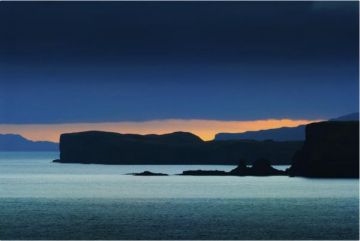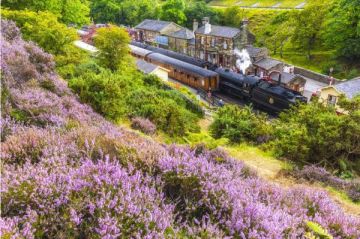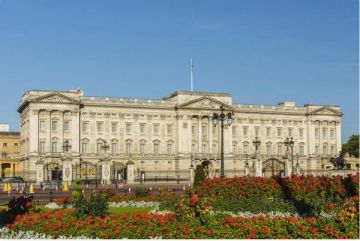CONTENT
1. Foot and Mouth update
2. UK Destinations
3. Bed and Breakfast bookings
4. UK Travel news and notes
Welcome friends, its time to put the kettle on, settle into a comfortable armchair, and enjoy the best of Britain with Britain Update. But before you do, please take the time to forward this newsletter to someone who loves Britain as much as you do.
David Ross, Publisher
******************************
Foot and Mouth Update
******************************
Tony Blair's government has officially declared the countryside "open for business" again after the restrictions imposed by the outbreak of foot and mouth disease. There's even a special website set up at http://www.openbritain.gov.uk/ to inform the world that it is once more safe to travel the backroads and byways of Great Britain. Like most government pronouncements, however, travellers are advised to take this news with a certain amount of scepticism.
While many of the countryside paths closed in efforts to control the spread of F&M are now open, quite a few restrictions remain in place. Stonehenge opened again on April 10 after 6 weeks of closure, and most historic houses are now open. Visitors can once more enjoy the safari park at Longleat. But many countryside paths in Cumbria, Cornwall, Derbyshire, and other popular countryside destinations remained closed and there are odd restrictions elsewhere; for example the Visitor Centre at Skara Brae is open, but the Neolithic village itself is closed (quite why one would want to visit the centre itself without seeing the village is open to question!).
Once again I'll advise people making travel plans to please check first with local tourism offices. For up to the minute information on whether your preferred destination has been affected by closure, the English Tourism Council has set up a national Visitors Information Hotline for people who want to visit, or take a holiday, in the English countryside. The line will is open seven days a week from 10.00 am - 8.00 pm.
*************************
UK Destinations: Islay
*************************
One largely rural area that has been largely passed over by the foot and mouth outbreak is the Isle of Islay in Scotlands Inner Hebrides. Islay is the most southerly of the islands that make up the Inner Hebrides, and also the largest. Just so you don't amuse the locals too much by pronouncing the island's name the way it looks, let me warn you that the correct pronunciation is 'eye-la' .
The history and culture of Islay is bound up with a Scotsman's favourite beverage - malt whiskey. There are no fewer than 7 active distilleries on the island, and all welcome visitors. The Laphroaigh Distillery http://www.laphroaig.com/ offers an unusual gift; every visitor to its web site is eligible for a lifetime lease on one square foot of Islay land, complete with a certificate of ownership!
There's more to Islay than whiskey, however. Bowmore, the capital of Islay, was the first planned town in Scotland. It was laid out on a rectangular grid pattern by Daniel Campbell in 1768. Campbell was also responsible for erecting one of only two round churches in Scotland. The church, not surprisingly called Round Church, is 67 feet in diameter and clad in striking white. Unsupported legend says that Round Church was built "with no corners for the devil to hide in".
Another planned town is Port Charlotte, named by the builder Walter Frederick Campbell after his mother. Port Charlotte boasts the award-winning Museum of Islay Life http://www.islaymuseum.freeserve.co.uk/ where visitors can trace the history of the island through exhibits as diverse as an illegal whiskey still, early Christian artefacts, and household implements from a 19th-century croft. A special display tells the tragic tale of historic shipwrecks on the island's rock coast. Also in Port Charlotte is the field centre of the Islay Natural History Trust, where you can learn about the diverse wildlife and flora of the island.
Near the small harbour town of Port Ellen are the ruins of 16th-century Dunyvaig Castle. Though originally owned by the MacDonalds of Dunivaig, the castle is now under the ownership of United Distillers! More MacDonald clan heritage survives at Finlaggan, the seat of the Lords of the Isles in the 14th and 15th centuries. Archaeological excavations show extensive remains of over 20 buildings, including a great hall and chapel. The visitor centre at Finlaggan is open April - October.
Just north of Port Ellen is Kildaltin, where the chapel boasts the superb Kildaltin Cross, the only remaining High Celtic cross in Britain, and one of the finest early Christian remains in the country.
Islay is a popular birding centre, with over 250 varieties of birds. The RSPB operates a birding centre at Gruinart with video cameras and high-powered binoculars available for use by visitors.
Other activities on Islay include trout fishing at the Dunlossit Estate, clay pigeon shooting at Cultoon, seal watching near Port Ellen, or simply relaxing on the excellent beaches. Regular day trips from Islay go to Jura and Colonsay.
Islay is reached by ferry from Kennacraig on the coast of the Kintyre Peninsula some 100 miles northwest of Glasgow. The ferry crossing takes about 2 hours. There is also a once-weekly ferry from Oban For a more direct approach, you can take a short air flight from Glasgow.
Web resources:
http://www.scotland-info.co.uk/islay.htm
http://www.highlandconnection.org/finlaggantrust.html
http://www.undiscoveredscotland.co.uk/areaisla/
******************************
Bed and Breakfast at Britain Express
******************************
Here's a reminder that Britain Express has partnered with Bed and Breakfast UK to bring you information on hundreds of bed and breakfast properties across the UK and Ireland. Browse the attractive collection of B&B properties at http://www.bedandbreakfasts-uk.co.uk/britainexpress/index.htm . Each B&B listing has details of facilities, contact information, prices, and a location map.
****************************
UK Travel Tips and News
****************************
LONDON HAS 'EUROPE'S LONGEST RIVER WALK
With the completion of a special section of cantilevered walkway at Southwark on the South Bank, London now boasts one of the longest uninterrupted stretches of river walkway in any European city. (From Vauxhall Bridge to beyond Southwark Bridge.) Joining parts of the existing path linking Shakespeare's Globe Theatre and Tate Modern art gallery with London Bridge Station, the new 120-metre section was the missing link in riverside improvements which, together with new attractions such as the Tate, have completely transformed the area. It is all part of the Millennium Mile, London's dramatic riverside, which starts at Westminster Bridge and includes the London Eye, the National Theatre and Design Museum
Website: http://www.southbanklondon.com
This, in turn, forms part of the Thames Path, itself the longest riverwalk in Europe, running for 175 miles to the river's source in the Cotswold Hills.
BEHIND THE SCENES AT HOUSES OF PARLIAMENT
It will be possible to go behind the scenes in for eight weeks this summer, when guided tours of the Houses of Parliament take place. The 75-minute tours will include a visit to the House of Lords and the Commons, finishing in the unique Parliamentary gift shop in Westminster Hall.
Tours run from Monday to Saturday August 6 - September 29, with none on public holidays or certain weekday mornings. Tickets cost £3.50 per person (no concessions). Tickets will be sold on the day, subject to availability, the organisers suggest it is advisable to book in advance, either in person at the ticket office in Westminster Hall (from mid-July) on the Web at http://www.ticketmaster.co.uk
MARCONI WIRELESS CENTENARY IN CORNWALL
The Poldhu Marconi Centre opens in Cornwall on December 12, on the site where, exactly 100 years earlier, the first trans-Atlantic radio transmission was made by Guglielmo Marconi. It was from the massive aerial of the Poldhu wireless station, near the village of Mullion 290 miles south-west of London, that three Morse Code dots signalling the letter 'S' were sent to Newfoundland, Canada.
The new centre, being built on land given to the National Trust by the Marconi company, will have a multi-media presentation telling the story of Marconi, and the history of radio and modern communications, and interactive displays, internet access and a remote user Web site
WELSH RAILWAY RUNS AGAIN AFTER 60 YEAR GAP
A "new railway for a new millennium", the Welsh Highland Railway, has started its first full season of daily steam trains (March 31). The little narrow-gauge line, running again for the first time in 60 years, starts its journey in the shadow of 13th-century Caernarfon Castle (on the North Wales coast) and goes for seven miles through the foothills of Snowdonia National Park. During 2001, construction continues to Rhyd Ddu, at the beginning of a footpath to Mount Snowdon, with a plan to eventually link with the historic Ffestiniog Railway. Many of the staff and engineers are volunteers and trains run daily until November 4. Web site: http://www.festrail.co.uk
SCOTTISH STEAM AND DOWNHILL CYCLING
Fancy riding a steam train on one of the world's most scenic railway routes? Or how about an adrenalin-pumping cycle ride down a mountain? You can do both in the Fort William area of the Scottish Highlands this year. The Jacobite Steam Train takes you along the West Highland Railway, built in 1901 and celebrating its centenary this year, past lochs and mountains to the Atlantic fishing port of Mallaig. During the 42-mile, six-hour round-trip, the train crosses the 100ft-high Glenfinnan viaduct at the head of Loch Sheil. Though ScotRail diesel trains make the trip daily, it is best experienced by steam train, which runs from Fort William Mon.-Fri. June 18 - Sept. 28 and Sun. July 29 - Sept. 2. Tickets cost £22 (adult) and £12.50 (child).
Britain's biggest downhill mountain bike track at Fort William is proving very popular. Specially adapted gondola cars take bikes and riders up Aonach Mor mountain-side to a 2,150ft-high launch point. Opening from May 18 - late September, the 2.6 mile long track is a must for thrill-seekers and spectators alike. A single trip costs £9.25, a multi-day trip ticket, £15. Web site: http://www.offbeatbikes.co.uk
Fort William, situated beneath Britain's highest mountain, Ben Nevis, is 104 miles north-west of Glasgow. Web site: http://www.lochaber.com
That's all for now. Until next issue, let me remind you that laughter is contagious. Be a carrier.
David Ross, Publisher, Britain Express



